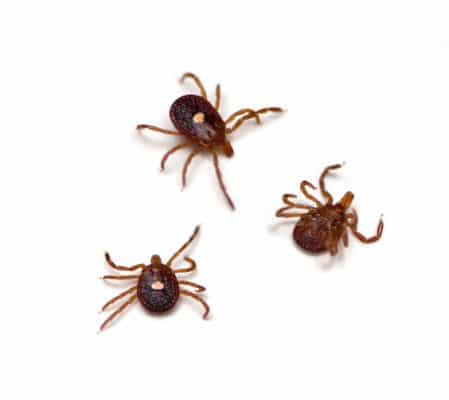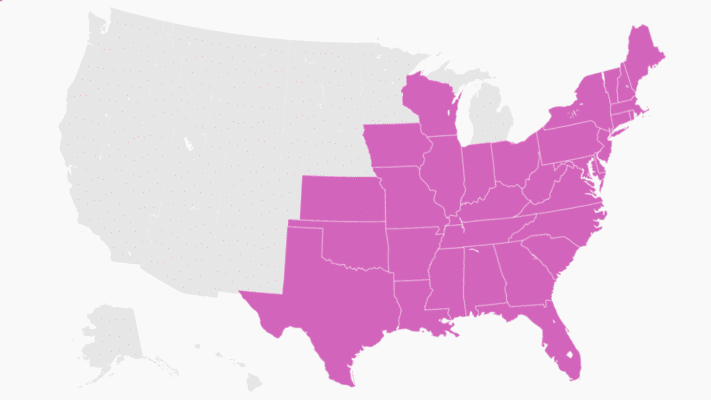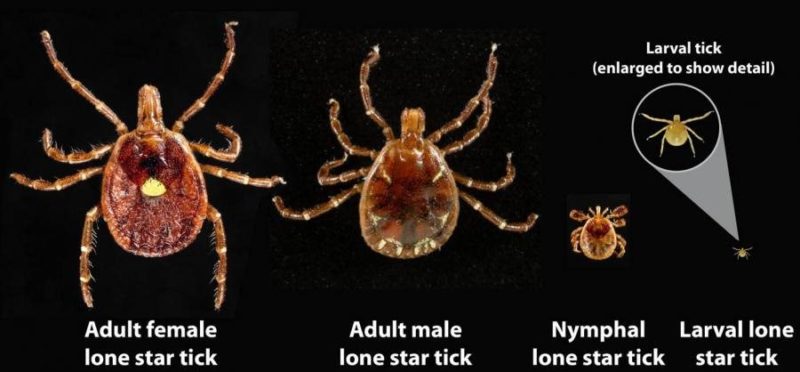
Unfortunately, yes. Lone star ticks have been found in all New England states. Originally, they were most commonly found in the southeastern United States, but now they’ve spread to the entire eastern half of the country. Like other ticks common to New England, lone star ticks are vectors of disease that can infect humans with their bite. But Modern’s Homecare Mosquito, Flea, and Tick service can help reduce the population of these potentially dangerous ticks on your property.

Are They from Texas?
The “lone star” in the name doesn’t have anything to do with Texas, the Lone Star State. Lone star ticks are named for the single white spot on the backs of the adult females. The spot can vary from cream to bronze/gold and can even appear iridescent at close range. Females are about 1/4-inch-long, and 1/2 inch or longer when fully engorged with blood. Adult males have light colored patterns on the outside of their bodies.
Our Homecare Mosquito, Flea, and Tick Program is proven to effectively reduce populations of all New England tick species. Get a quote or schedule service today!
The Life of the Lone Star
Lone star ticks go through the usual tick life stages of egg, larva, nymph, and adult. Lone stars are three-host ticks like other ticks in New England. This means they need to feed on the blood of a different host at each level of development in order to complete their life cycle.
Lone star ticks are most active mid-March through September in New England, depending on their stage. Adult lone star ticks are most active from mid-March through late June. Nymphs are most active mid-May through late July, and larvae are most active July through September. Lone star ticks tend to be found near rivers and streams where animals rest. They also prefer shrub undergrowth and dry, forested areas.

Hunting and Questing
The hosts can range from small animals like chipmunks and mice, all the way up to deer and humans. Other types of local ticks find their hosts by “questing”. Questing is when a tick climbs to the end of a blade of grass or other structure and outstretches its front legs. This increases the tick’s chances of attaching to a potential host. Unlike other species, lone star ticks are known to move long distances in pursuit of hosts and “hunt” them.
At the adult stage, ticks are looking for mates. When an adult female tick is fertilized and engorged on a blood meal, she will drop off her host after 7 to 10 days and lay up to 3,000 eggs.
Vectors of Disease
While the larvae do not carry disease, the nymphal and adult stages can transmit diseases to their hosts while they feed. Lone star ticks have been known to transmit pathogens that cause ehrlichiosis, tularemia, Heartland virus, Bourbon virus, and Southern tick-associated rash illness (STARI).
Allergic reactions from eating red (mammalian) meat have also been linked to lone star ticks. When the tick bites a human host, a sugar carbohydrate called alpha-gal can enter the person’s blood stream. Alpha-gal is found in beef, lamb, and pork, but not humans. Some people develop antibodies to alpha-gal and have an allergic reaction 4-8 hours after eating red meat. The reaction may include itching, burning hives, swelling of the throat, and anaphylactic shock.
Our Homecare Mosquito, Flea, and Tick Program focuses on the areas of your property that your family and pets use most. Click here or call Modern at 1-800-323-7378 to get a free quote or schedule service today!
How Can You Avoid Lone Star Ticks?
If you take precautions, you can reduce the risk of contracting a tick-borne illness.
- Since lone star ticks prefer forested areas near rivers and streams, it’s important to be aware of them when you’re outdoors.
- Wear long sleeves and pants, and tuck pantlegs into your socks to keep ticks from attaching to your skin.
- Use a bug repellent containing DEET, picaridin, Oil of Lemon Eucalyptus (OLE), or IR3535 on your skin (follow the label instructions) or wear clothes treated with permethrin.
- Shower and do tick checks after you’ve been outside.
- If you do find a tick attached to you, use tweezers or a tick spoon to pull it straight out of the skin (don’t leave any tick mouthparts behind).
The Modern Solution
When you’re home, you don’t want to worry about lone star ticks. Modern can provide peace of mind when you’re enjoying your outdoor space. Modern’s Homecare Mosquito, Flea, and Tick service is proven to effectively reduce the population of lone star and other New England tick species like black-legged, American dog, and brown dog ticks. It also reduces the populations of mosquitoes and fleas. The program consists of six monthly treatments from April through September. Each treatment is $99 for up to one acre of land ($50 for each additional half acre). Call Modern now at 1-800-323-7378 for a free quote or to schedule service. It’s not too late to start, and any unused treatments roll over to next year.
